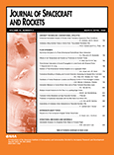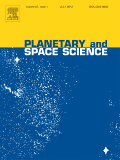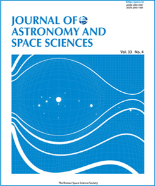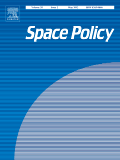
Space Science and Technology-Kosmicna Nauka i Tehnologia
Scope & Guideline
Pioneering discoveries in space science and technology.
Introduction
Aims and Scopes
- Space Exploration Technologies:
The journal extensively covers the development and application of new technologies for space exploration, including propulsion systems, spacecraft design, and robotics. - Planetary Science and Lunar Studies:
Research on planetary bodies, particularly the Moon, is a significant focus, exploring aspects such as surface composition, geological history, and resource utilization. - Satellite Communication and Networking:
The journal publishes work related to satellite communications, including advancements in 6G networks and satellite constellation management. - Space Debris Management:
A core area of research involves strategies for tracking, predicting, and mitigating space debris, reflecting growing concerns over space traffic management. - Space Medicine and Human Factors:
The journal addresses the health and performance of astronauts, focusing on the effects of microgravity and long-duration space missions on human physiology. - Astrobiology and Life Detection:
Investigation into the potential for life beyond Earth, including studies on extremophiles and the implications for human exploration of other planets. - Theoretical and Computational Models:
A strong emphasis is placed on the use of simulations and theoretical models to understand complex space phenomena and optimize mission planning.
Trending and Emerging
- Artificial Intelligence in Space Operations:
There is a growing trend toward integrating AI and machine learning into space operations, from autonomous navigation to data processing, enhancing efficiency and decision-making. - In Situ Resource Utilization (ISRU):
Research focused on ISRU, particularly for lunar and Martian missions, is gaining traction as the feasibility of long-term human presence in space becomes a priority. - Space Traffic Management and Policy:
As the number of satellites increases, themes related to space traffic coordination and policy development are emerging, highlighting the need for governance in crowded orbits. - Interplanetary Supply Chain and Logistics:
The exploration of logistical frameworks for supporting interplanetary missions is becoming increasingly relevant, reflecting a strategic shift in mission planning. - Health and Safety in Space Missions:
There is a notable increase in research addressing the health risks and safety measures for astronauts, emphasizing psychological and physiological well-being during missions. - Sustainable Space Practices:
Emerging themes include sustainability in space exploration, with research focusing on minimizing environmental impacts and ensuring the longevity of space activities.
Declining or Waning
- Traditional Space Physics:
Research related to classical space physics, such as basic atmospheric studies and magnetic field investigations, has seen a decrease in publication frequency amid the rise of technology-driven research. - Historical Space Missions:
Papers focusing on historical analyses of past missions and their outcomes are becoming less common, possibly overshadowed by current and future mission planning. - Low-Gravity Agricultural Studies:
While previously a niche area of interest, studies specifically focused on agriculture in low-gravity environments are diminishing as the focus shifts to more comprehensive life support systems. - Non-Space-Based Environmental Studies:
Research that applies space technology to terrestrial environmental issues is less frequently published, as the journal pivots towards more space-centric applications. - Basic Theoretical Astrophysics:
Submissions that delve into purely theoretical astrophysics, without a direct connection to space applications or missions, are decreasing in favor of more applied research.
Similar Journals

SPACE SCIENCE REVIEWS
Bridging Disciplines in the Quest for Cosmic UnderstandingSPACE SCIENCE REVIEWS, published by Springer, is a premier interdisciplinary journal that has been at the forefront of space science research since its inception in 1962. With an impressive impact factor and a distinguished Q1 ranking in both Astronomy and Astrophysics, as well as Space and Planetary Science, it stands as a leading platform for the dissemination of cutting-edge research. The journal encompasses comprehensive reviews covering a diverse array of topics, from cosmic phenomena to planetary exploration, serving as a critical resource for researchers, professionals, and students alike. Although it operates primarily under a subscription model, its commitment to excellence and rigorous peer-review process ensures that each article meets the highest standards of scientific integrity. With its headquarters in the Netherlands, SPACE SCIENCE REVIEWS is positioned strategically to foster global collaboration in the field, making it an invaluable asset for anyone interested in the ever-evolving landscape of space science.

JOURNAL OF SPACECRAFT AND ROCKETS
Transforming Ideas into Aerospace Reality.The Journal of Spacecraft and Rockets, published by the American Institute of Aeronautics and Astronautics, serves as a premier platform for disseminating cutting-edge research in the fields of aerospace engineering and space science. Established in 1964, this esteemed journal has evolved over nearly six decades, solidifying its reputation with a consistent publication history through 2024. With an impact factor positioning it within the Q2 quartile in both Aerospace Engineering and Space and Planetary Science categories, it ranks as a vital resource, featuring high-quality manuscripts that address the latest advancements and findings in spacecraft design, propulsion systems, and austere planetary exploration. The journal's rigorous peer-review process ensures that articles meet the high academic standards expected by practitioners in the aerospace sector. Researchers, engineers, and students alike will find the Journal of Spacecraft and Rockets to be an invaluable resource for both foundational knowledge and innovative research developments, advancing the future of aeronautics and astronautics.

Chinese Space Science and Technology
Showcasing Breakthroughs in Space TechnologyChinese Space Science and Technology is a pivotal journal dedicated to advancing the field of space engineering and technology, published by the esteemed Chinese Academy of Space Technology. With an ISSN of 1000-758X, this publication serves as a significant platform for cutting-edge research from China and around the globe, spanning vital intersections of Aerospace Engineering, Electrical and Electronic Engineering, and Materials Science. As evidenced by its Q3 ranking in 2023 across these categories, the journal consistently showcases innovative studies that contribute to the development of space technology, thereby impacting both theoretical frameworks and practical applications in the industry. Researchers and professionals will find valuable insights within its pages, while students can enrich their educational journey through its wealth of knowledge. Though primarily published in print, the journal continues to foster collaboration and engagement among the academic community, offering a glimpse into the future of space exploration and technological advancements through its relevant and timely content.

Advances in Astronomy and Space Physics
Connecting Ideas, Advancing Knowledge in Space Research.Advances in Astronomy and Space Physics is an esteemed journal dedicated to the exploration and dissemination of research in the expansive fields of astronomy and space science. Published by Taras Shevchenko National University of Kyiv, this journal provides a platform for researchers, professionals, and students to share groundbreaking studies and innovations. With an ISSN of 2227-1481, it covers a wide range of subjects including astrophysics, planetary sciences, and space exploration technologies, thereby fostering interdisciplinary collaboration. Although not an Open Access journal, it maintains a commitment to high-quality, peer-reviewed content that contributes significantly to the advancement of scientific knowledge. The journal's mission is to promote sustainable practices in space research while also exploring the implications of discoveries on Earth and beyond. By maintaining rigorous publication standards, Advances in Astronomy and Space Physics aims to serve as a critical resource for those involved in the ever-evolving study of our universe.

Journal of Space Safety Engineering
Exploring the intersection of engineering and space safety.The Journal of Space Safety Engineering, published by ELSEVIER, is a pioneering platform dedicated to advancing the field of aerospace safety and engineering. Since its inception in 2014, this journal has catered to researchers and professionals focusing on the crucial intersection of aerospace engineering and safety, risk, reliability, and quality management. With an ISSN of 2468-8975 and E-ISSN of 2468-8967, it has established itself within the academic community, currently holding a Q3 ranking in both Aerospace Engineering and Safety, Risk, Reliability, and Quality categories, according to the 2023 metrics. The journal, which covers converged years up to 2024, is instrumental for those seeking to explore innovative safety solutions in space missions and exploration, making it an essential resource for students, industry professionals, and researchers alike. Although it is not open access, it remains a credible source of impactful studies that contribute to enhancing safety protocols and engineering practices in aerospace endeavors. With a strong focus on rigorously vetted research, the Journal of Space Safety Engineering ensures that important advancements in this dynamic and vital field are shared widely among experts and stakeholders.

Solar-Terrestrial Physics
Empowering Research in Atmospheric, Geophysical, and Planetary SciencesSolar-Terrestrial Physics is a pivotal Open Access journal dedicated to advancing the understanding of the complex interactions between solar and terrestrial phenomena. Published by the NAUCNO-IZDATELSKIJ CENTR INFRAM in the Russian Federation, this journal has established itself as a significant platform for disseminating cutting-edge research within the fields of Atmospheric Science, Geophysics, and Space and Planetary Science. Since its transition to Open Access in 2017, it has bolstered academic accessibility, fostering the dissemination of knowledge to a global audience. With its current category quartiles ranking Q4 in Atmospheric Science and Q3 in both Geophysics and Space and Planetary Science, it actively contributes to the scholarly dialogue essential for innovation and research development. Researchers and practitioners can submit their work with ease, knowing their contributions will reach an engaged audience. The journal is an essential resource for those focused on exploring the dynamics of solar-terrestrial relationships, critical for understanding broader planetary systems.

Journal of the Korean Society for Aeronautical and Space Sciences
Leading the Way in Aeronautical DiscoveriesThe Journal of the Korean Society for Aeronautical and Space Sciences is a dedicated platform for the dissemination of cutting-edge research in the fields of aerospace engineering and space sciences. Published by the esteemed Korean Society for Aeronautical & Space Sciences, this journal aims to bring together innovative findings and technological advancements from around the globe, thereby contributing to the ongoing development of the aerospace sector. Operating from South Korea, the journal holds an ISSN of 1225-1348 and an E-ISSN of 2287-6871, catering to both print and digital scholarly communication. Although categorized in Q4 within the Aerospace Engineering segment and ranked 139 out of 153 on Scopus, the journal plays a crucial role in fostering research collaboration and knowledge exchange among professionals, researchers, and students alike. With converged years from 2019 to 2024, it continuously seeks to enhance its contributions to the academic community through rigorous peer review and publication of original research. Given the evolution of aerospace technologies, this journal is vital for anyone involved in aeronautical research, ensuring that their work reaches the right audience.

PLANETARY AND SPACE SCIENCE
Unlocking the Universe: Insights into Planetary Bodies and BeyondPLANETARY AND SPACE SCIENCE is a leading journal dedicated to the interdisciplinary field of astral studies, encompassing both planetary science and the exploration of space. Published by PERGAMON-ELSEVIER SCIENCE LTD in the United Kingdom, this journal has been pivotal since its inception in 1959, continually contributing to advancements in research about planetary bodies, their atmospheres, and the broader cosmic landscape. With an impressive impact factor, PLANETARY AND SPACE SCIENCE ranks in the second quartile of Astronomy and Astrophysics and the third quartile in Space and Planetary Science as of 2023, showcasing its scholarly significance. The journal aims to provide a platform for the dissemination of cutting-edge research, emphasizing the critical role of space exploration and planetary studies in understanding our universe. Researchers, professionals, and students alike are encouraged to explore the wealth of knowledge presented in its pages, fostering a deeper comprehension of the phenomena that shapes both our solar system and beyond.

Journal of Astronomy and Space Sciences
Fostering Collaboration for a Deeper Cosmic Insight.The Journal of Astronomy and Space Sciences, published by the Korean Space Science Society, is a premier open-access platform dedicated to advancing the fields of astronomy, astrophysics, and space sciences. Established in 1984, the journal has been instrumental in disseminating high-quality research findings, fostering collaboration among scientists globally, and providing insights into the dynamics of our universe. With an ISSN of 2093-5587 and an E-ISSN of 2093-1409, the journal has gained notable recognition, currently ranking in the Q3 quartile in Earth and Planetary Sciences and Physics and Astronomy as of 2023. Although the journal's H-Index is currently unspecified, its commitment to rigorous peer-review processes and open-access availability ensures that groundbreaking research is accessible to a wide audience. Based in Seoul, South Korea, the journal is poised to continue supporting innovative research through 2024 and beyond. Researchers, professionals, and students alike will find valuable resources and opportunities within its pages, further establishing this journal as a crucial resource in the exploration of the cosmos.

SPACE POLICY
Advancing Knowledge on the Strategic Use of Space Resources.SPACE POLICY is a premier academic journal published by Elsevier Science Ltd that focuses on the interdisciplinary field of space policy, exploring the myriad issues that arise in the governance and strategic use of space resources. With an ISSN of 0265-9646 and an E-ISSN of 1879-338X, this journal addresses critical topics pertinent to economics, law, sociology, and political science, making it an essential resource for researchers, policymakers, and academicians. Since its inception in 1985 and continuing through to 2024, SPACE POLICY has garnered strong recognition, achieving Q1 and Q2 rankings in various categories as of 2023, indicating its significant impact in both theoretical and applied research. Although it operates on a subscription basis, the journal's commitment to delivering high-quality, rigorous research ensures it remains at the forefront of discourse on the socio-political implications of space exploration and utilization. Whether you are a seasoned researcher or a student delving into the complexities of space governance, SPACE POLICY provides a vital platform for advancing knowledge and debate in this rapidly evolving field.